Exploring Soft Close Door Hinges: A Comprehensive Guide
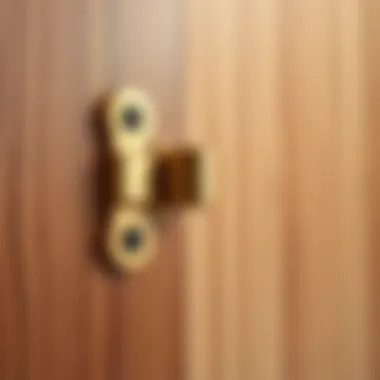
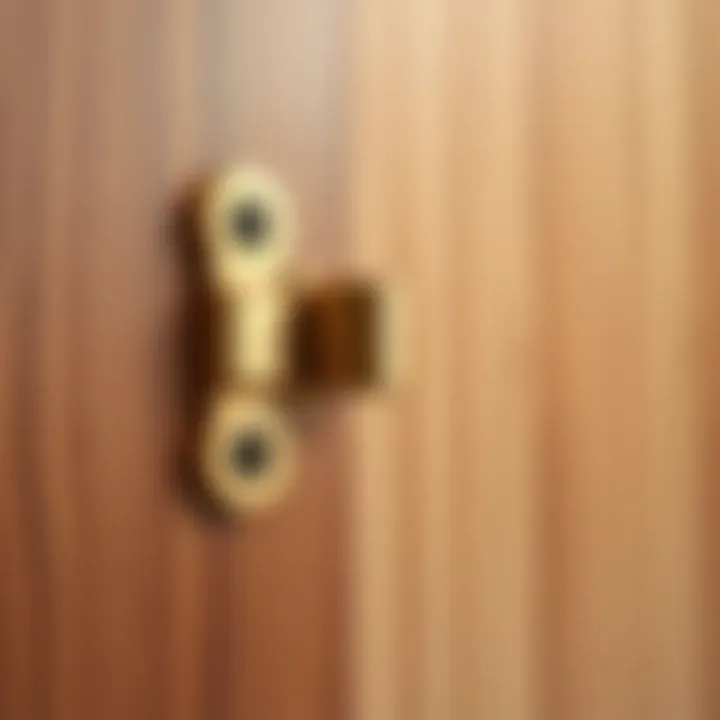
Intro
In recent years, the world of interior design has transformed significantly. One of the key innovations in this realm is the soft close door hinge, a small but mighty component that enhances the functionality and aesthetics of doors. These hinges are a game-changer, offering a mechanism that ensures doors close quietly and securely, without the chance of slamming. This article delves into the nuances of soft close door hinges, illuminating how they operate, their benefits, and the installation processes involved.
Furniture Design Trends
Current Styles and Themes
Soft close door hinges are not just about function; they align perfectly with contemporary design styles that favor clean lines and minimalism. As homeowners and designers gravitate towards open spaces with sleek transitions, the soft close mechanism complements this movement gracefully. Think of mid-century modern or Scandinavian designs where simplicity reigns and every detail counts. Incorporating these hinges can elevate a room's aesthetics while serving practical purposes.
Color Palettes and Materials
When considering soft close hinges, the color and material selection also play a crucial role. Most hinges come in a variety of finishes such as brushed nickel, matte black, and polished chrome. Choosing a finish that syncs with the overall theme of your space can make a world of difference. For instance, a rustic kitchen may benefit from oil-rubbed bronze hinges that resonate with wooden cabinets, while a sleek, modern apartment could opt for silver or white finishes to preserve that contemporary vibe.
Practical Furniture Tips
How to Choose the Right Size
Selecting the right size hinge is paramount to ensuring functional and aesthetic coherence. Consider the weight and thickness of your doors. Most standard interior doors weigh between 30 to 50 pounds. Using soft close hinges rated for heavier doors, such as those made from solid wood, prevents the risk of wear and ensures smooth operation. Measure both the height and width of the door and match it with the specifications of your chosen hinge to avoid installation headaches later.
Maintenance and Care for Longevity
To keep your soft close hinges performing like new, some general maintenance tips come in handy:
- Regularly Lubricate: Use a light machine oil to lubricate the hinges at least once a year.
- Check Screws: Periodically inspect screws and fittings to ensure they are tight, preventing wobbling or misalignment.
- Clean with Care: Wipe down hinges with a soft cloth to prevent the buildup of dust and grease that can impair functionality.
"Choosing appropriate hardware not only enhances the beauty of your space but also extends the lifespan of your furniture."
In saying that, understanding soft close door hinges involves an appreciation of both style and practicality. Thus, this guide aims to equip homeowners, interior designers, and DIY enthusiasts with the nuanced knowledge needed to navigate this often-overlooked aspect of furniture design effectively.
For further reading, check out sources like Wikipedia and engage with communities on Reddit for more tips and experiences.
Understanding Soft Close Door Hinges
Soft close door hinges have emerged as a significant element in modern carpentry, transforming how we interact with doors. They offer not just functionality but an unexpected level of sophistication keeps things less chaotic. Their importance cannot be overstated, as they enhance the user experience and prevent those bothersome door slams that often send shockwaves through a quiet home. Anyone who has wrestled with a stubborn door or had the misfortune of pinched fingers will understand why these hinges are so appealing.
Definition and Mechanism
At their core, soft close door hinges are designed to manage the closing motion of a door. They incorporate a hydraulic mechanism that gradually slows down the door's closing speed. When the door approaches its closed position, instead of shutting abruptly, the hinge action makes it glide shut with just enough resistance to keep the noise at bay. It operates like a gentle embrace, allowing the door to come to rest without any startling thunk. This mechanism is often hidden within the hinge, maintaining the sleek look of the door. Typically made from stainless steel or durable metals, these hinges ensure longevity.
History and Evolution
The journey of soft close hinges dates back to the early 20th century, although the mainstream popularity gained momentum much later. Originally, they were seen in commercial and high-end products; think luxury hotels or designer kitchens where functionality and aesthetics were paramount. Over the years, advancements in hydraulic technology and materials have allowed for the incorporation of soft close mechanisms into more affordable options. Today, they can be found in a variety of settings, from kitchens to bathrooms, proving that innovation has not only improved performance but also accessibility.
As homes became smarter and design trends shifted towards minimalistic and function-driven approaches, the demand for soft close hinges surged. They now cater to a broad audience, from everyday homeowners seeking to enhance their comfort to designers keen on incorporating functionality within elegant designs.
Understanding these hinges is crucial, especially for anyone involved in interior design or furniture retail. Their integration into home design is not just practical; it also adds a layer of refinement to any space. Upgrading to soft close hinges is almost like adding a dash of class—unassuming yet rich in merit.
Benefits of Soft Close Hinges
Soft close door hinges offer a multitude of advantages that enhance both the functionality and aesthetics of doors in various settings. These specialized hinges are more than just a mechanism; they bring about notable changes in our daily interactions with doors. Their primary appeal lies in making door operation seamless, which can significantly improve living spaces. From reducing noise to increasing safety, the benefits are far-reaching, making soft close hinges an attractive option for homeowners and design professionals alike.
Noise Reduction
One of the standout features of soft close hinges is their ability to minimize noise. Traditional door hinges often result in loud slams as doors close, which, depending on the setting, can be quite disruptive. This is particularly crucial in quiet environments such as libraries or homes with small children who might be napping.
Soft close hinges, equipped with hydraulic mechanisms or cushions inside the hinge, ensure that doors close gradually and silently. The result is a gentle touchdown that prevents the jarring sounds associated with normal door usage. The functionality is especially beneficial in high-traffic areas or open-plan homes, where noise can reverberate easily, creating a disturbance.
Safety Features
When it comes to safety, soft close hinges shine with several key characteristics:
Child Safety
Focusing specifically on child safety, these hinges offer peace of mind for families with small kids running about. The slow, controlled closing action of these hinges minimizes the risk of tiny fingers getting caught in the door. Unlike standard hinges, which can shut quickly and cause painful injuries, soft close mechanisms allow for a slower closure, providing an extra moment for children to move out of harm's way. This safety feature is frequently highlighted as a primary motive for many parents opting for soft close hinges in their homes.
Key Characteristic:
Gentle closure prevents injuries and gives parents confidence.
An invaluable addition to any safe environment for children.
Durability Enhancement
Soft close hinges also excel in durability, which contributes significantly to their appeal. They are designed to withstand repeated use without signs of wear and tear, something often overlooked with traditional hinges. The internal mechanisms are constructed to absorb the impact when the door closes, thereby reducing stress on the hinges themselves.
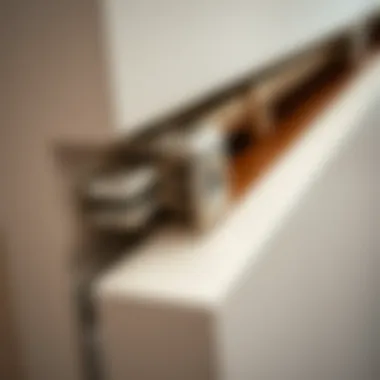
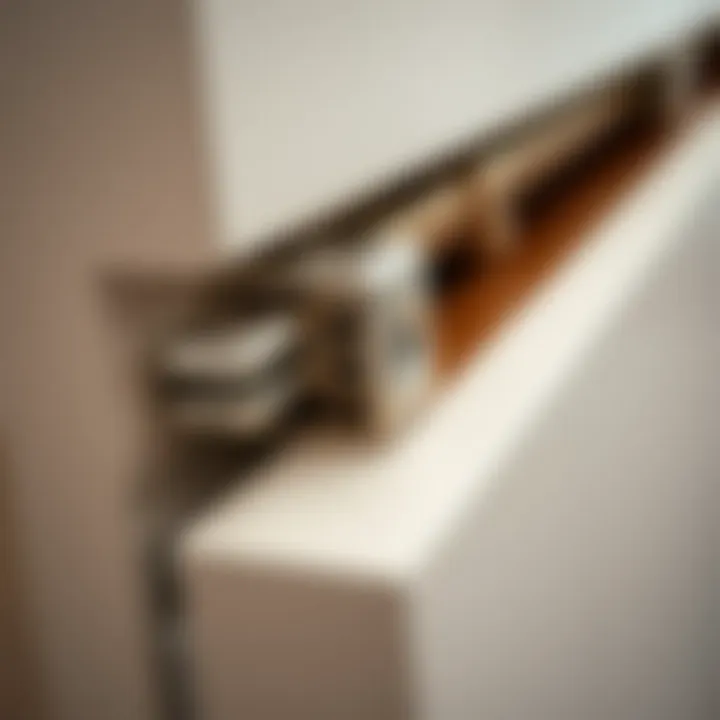
Key Characteristic:
Robust construction keeps hinges functional longer.
An investment that pays off in longevity, maintaining hardware quality over time.
Frequent replacements of conventional hinges can become a hassle, resulting in potentially higher costs over the long haul. Choosing durable soft close hinges can mitigate these issues, ensuring smooth operation for years down the line.
Preservation of Door Integrity
Finally, soft close hinges play a crucial role in preserving the integrity of doors. The gentle closure reduces the likelihood of warping or damage that can occur over time with more aggressive closing mechanisms. This is particularly significant for finer materials, like solid woods or engineered doors, where even minor dings can affect aesthetic appeal.
In summary, the soft close system stands out in the door hinge market, appealing to those prioritizing functionality, safety, and longevity. Whether it's for enhancing a home environment or elevating a design project, recognizing these benefits can lead to a more harmonious door experience and greater overall satisfaction.
Types of Soft Close Hinges
Understanding the various types of soft close hinges is paramount in making informed decisions that enhance both functionality and style in home design. Each type comes with unique characteristics, merits, and appropriate contexts, shaping the way doors operate and integrate into a living environment. Homeowners and interior decorators need to consider not only the mechanical properties but also the aesthetic appeal when choosing the right hinge type for their specific applications.
Self-Closing Hinges
Self-closing hinges represent one of the most practical choices for many households. These hinges automatically draw the door closed after it has been opened, ensuring seamless operation. They are particularly useful in busy environments, such as kitchens or bathrooms, where hands might be occupied. By reducing the chances of leaving doors ajar, these hinges help maintain privacy and improve energy efficiency.
One must note that self-closing hinges also tend to be quite durable, able to withstand the rigors of constant use. They come in various designs, accommodating both modern and traditional aesthetics, allowing homeowners flexibility in selection.
Benefits of Self-Closing Hinges:
- Increased security: Automatically closes doors, keeping them shut.
- Energy efficiency: Helps maintain temperature by preventing drafts.
- Ease of use: Excellent for hands-free operation, making them user-friendly.
Piano Hinges
Piano hinges, also known as continuous hinges, run the entire length of a door or panel. Named for their historical use in grand pianos, these hinges offer both stability and functionality. Their design provides a high degree of strength, distributing weight evenly. This is particularly beneficial for heavy doors, granting them smooth operation without risk of warping or misalignment.
In terms of aesthetics, piano hinges may not draw attention as they blend seamlessly into the door itself when installed correctly. They can be used in a variety of settings, from residential to commercial spaces, and are ideal for larger installations or specialty applications where a standard hinge would fall short.
Advantages of Piano Hinges:
- Stability: Even weight distribution supports larger and heavier doors.
- Durability: Typically made from robust materials, resistant to wear and tear.
- Versatility: Suitable for diverse applications beyond mere doors, including cabinets and panels.
Overlay Hinges
Overlay hinges are designed for doors that cover the cabinet frame entirely, commonly seen in modern cabinetry. They provide an aesthetic appeal where hinges are hidden when the door is closed, creating clean lines and a polished look. This type of hinge allows for a more streamlined design, indispensable in contemporary interior design.
Most overlay hinges have built-in soft-close mechanisms that ensure the door closes quietly and smoothly, enhancing user experience. Installation flexibility also makes them appealing; they can adapt to different door styles, thicknesses, and materials.
Features of Overlay Hinges:
- Aesthetic appeal: Hidden from view, offering a sleek appearance.
- Soft close mechanism: Prevents slamming, providing a gentler closing action.
- Ease of installation: Designed for various door styles and thicknesses, accommodating diverse cabinetry and furniture.
Selecting the right type of soft close hinge is essential to meet functional requirements while considering the overall look of your interiors. By understanding the differences among self-closing, piano, and overlay hinges, homeowners and designers can make informed choices that elevate both practicality and style in their spaces.
Installation Process of Soft Close Hinges
Installing soft close hinges is a pivotal element in enhancing the functionality and user experience of doors. This process not only improves the smoothness of door operation but also adds style and safety to your home. By choosing to install soft close hinges, you ensure that doors shut gently, reducing noise and wear on both the hinges and the door itself. These hinges also bring in a sense of modernity to your interiors, marrying form and function beautifully.
Tools Required
Before diving into the installation, it’s crucial to gather all the necessary tools. Here’s a list of what you’ll need:
- Screwdriver (Phillips and flathead)
- Drill with drill bits
- Tape measure
- Level to ensure everything is straight
- Chisel for any necessary adjustments
- Vise clamps (optional, but useful for holding parts in place)
- Safety glasses to protect your eyes
Having the right tools at hand can make the installation process more efficient and less frustrating. It saves you the hassle of running to the hardware store mid-installation, which can be a real time-waster.
Step-by-Step Installation Guide
Installing soft close hinges involves several steps that require attention and accuracy. Below is a detailed guide to help you through the process.
Preparing the Door
Preparing the door is the first step in ensuring a successful installation of soft close hinges. Start by removing the existing hinges if you’re replacing them. This step not only clears the path but also allows for a thorough inspection of the door and frame. A good practice is to check if the hinges don’t just fit snugly but are also aligned well.
Key Characteristic: A well-prepared door prevents misalignment during the installation process. This is crucial for the smooth operation of the hinges once installed.
Benefits: Proper preparation helps avoid complications later, such as doors that stick or do not close properly.
Mounting the Hinges
Once the door is prepared, the next task is the mounting of the hinges. The placement of the hinges should be precise, generally about 7 inches from the top and bottom of the door, which balances the load effectively. Use a level to ensure that they are perfectly aligned.
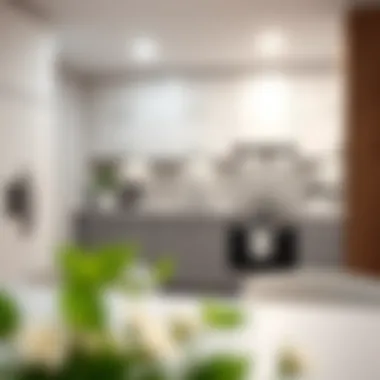
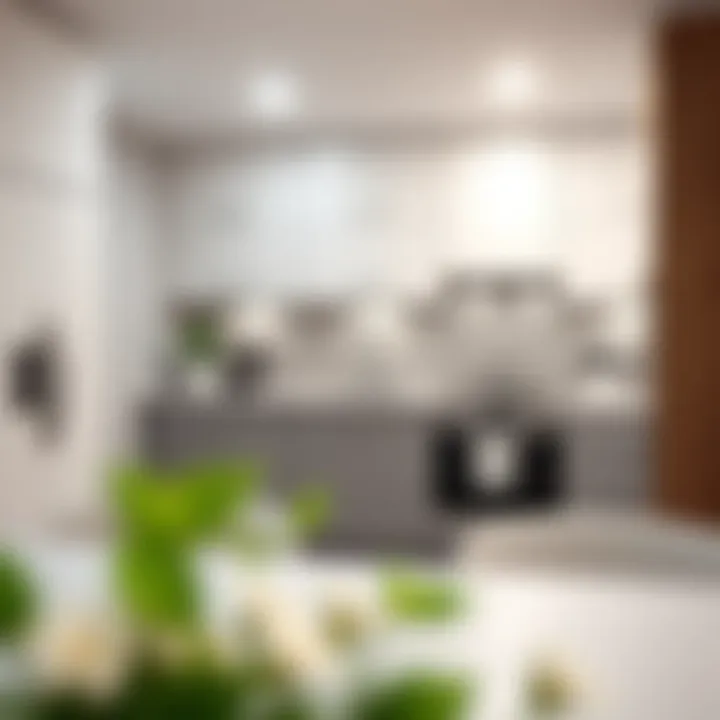
Key Characteristic: Accurate hinge placement is essential for functionality. If placed too high or low, the door may not operate smoothly.
Advantages: When hinges are properly mounted, it promotes even wear, enhancing their lifespan and functionality.
Adjustments for Perfect Closure
After mounting, adjustments are necessary to ensure the door closes seamlessly. Most soft close hinges come with an adjustment screw that allows for fine-tuning. It’s important to adjust the soft closing mechanism so that it engages at the perfect time, preventing both slamming and incomplete closures.
Key Characteristic: The adjustability of hinges allows homeowners to customize the functionality according to their preference.
Benefits: Proper adjustments lead to an even better user experience with doors closing softly every time, ultimately adding to the peace and quiet of your home.
"A well-installed soft close hinge not only makes a door operate quietly but also enhances the overall aesthetics of the space."
With these steps, the installation of soft close hinges should be straightforward and effective. Consider following this structured approach to ensure success, creating a tranquil and stylish environment in your home.
Maintaining Soft Close Hinges
Maintaining soft close hinges is crucial for ensuring their longevity and proper functionality. These hinges, designed to provide a smooth closing motion, can lose their effectiveness if not cared for. Just like any other component in a home, neglect can lead to wear and tear, making the hinges sluggish or even ineffective over time. Without proper maintenance, homeowners may find themselves dealing with noisy, problematic doors that fail to close softly, disrupting the peace and tranquility of their space.
Routine Maintenance Tips
To make sure your soft close hinges function as intended, it can be beneficial to incorporate some routine maintenance into your home care regimen. Here’s a compact yet comprehensive rundown of effective strategies:
- Regular Inspections: Check the hinges periodically for any signs of distress such as rust or dirt accumulation.
- Cleaning: Use a soft cloth and mild detergent to wipe down the hinges. Dirt can inhibit the mechanism's smooth operation.
- Lubrication: Every few months, apply a silicone-based lubricant to the hinges. This can prevent squeaking and ensure a smoother closing action. Be sure to avoid oil-based lubricants which can attract dust and grime.
- Tightening Loose Screws: Over time, screws may loosen due to regular use. Tighten them to keep the hinges secure and functional.
Implementing these practices can significantly extend the life of your soft close hinges and maintain their operational efficiency.
Common Issues and Solutions
Even with regular maintenance, issues may arise with soft close hinges. Identifying these problems early can save homeowners from bigger headaches later. Here are some common issues one might encounter:
- Door Slams Shut: If the door does not close softly anymore, it may be due to insufficient lubrication. Apply silicone lubricant and check if this resolves the issue. If it persists, examine for damage to the hinge mechanism.
- Hinge Noise: If you hear squeaking or grinding sounds when opening or closing doors, the dirt buildup may be the culprit. Clean the hinges carefully, ensuring no debris obstructs the moving parts.
- Door Misalignment: If the door does not align properly, it might hinder the soft close function. Check the hinge screws for tightness. If the door is still misaligned, you may need to adjust the hinges or consult a professional for assistance.
By understanding these common problems and their solutions, homeowners can take proactive steps to keep their doors functioning smoothly. Addressing issues promptly not only maintains the quality of the soft close hinges but also contributes to the overall aesthetic and functionality of the home.
Remember: An ounce of prevention is better than a pound of cure. Regular maintenance can prevent a significant amount of frustration down the line.
Choosing the Right Soft Close Hinges
Selecting the appropriate soft close hinges might seem like a trivial task, but it carries weight. The right hinges can elevate not just the functionality of your doors, but also their aesthetic charm. Understanding what characteristics to prioritize — from door weight to material finishes — is crucial in making a decision that aligns with your needs. Choosing wisely ensures that you maximize the efficiency and aesthetic of your home or project.
Factors to Consider
Door Weight and Size
When contemplating the door weight and size, it’s essential to recognize that these factors heavily impact the hinge selection process. Robust doors, like solid wood or heavy-duty versions, require heavier hinges capable of withstanding their weight. On the other hand, lighter doors may not need such substantial support, which can open avenues for options that are less bulky. The key characteristic that stands out here is strength; heavier-duty hinges tend to offer better longevity and more seamless operation.
When obtaining hinges suitable for heavier doors, look for features like reinforced materials and precise balancing mechanisms. This is a beneficial choice for a home with large entryways or a modern design that showcases heavier, industrial-style doors. However, opting for heavier hinges might slightly complicate installation and increase costs.
Style of Door
The style of door you’re working with significantly shapes the hinge choice. Whether you’re looking at classic French doors, contemporary sliding doors, or sleek cabinets, the compatibility of hinges with these styles can’t be overlooked. This aspect comes into play not just in functionality but also visually; the hinges should complement the door design.
For instance, if you have ornate wooden doors, employing traditional decorative hinges could augment their appeal, making them stand out. Conversely, minimalist styles might look best with contemporary, streamlined hinges. The unique feature here is versatility; hinges can be chosen with finishes that match the door materials, therefore blending in. Be cautious, though, as the wrong combination could create a jarring mismatch that detracts from the overall aesthetic.
Finishes and Materials
Finishes and materials play a pivotal role in both durability and design harmony. Soft close hinges come in various materials such as stainless steel, brass, or even high-quality plastic. The material not only dictates the strength but also influences aesthetic choices. For example, a brushed nickel finish could give a sleek and modern look, perfect for urban living spaces.
The key characteristic here is the balance between durability and aesthetics. Selecting materials resistant to rust or corrosion, like stainless steel, ensures that hinges retain their function and appearance over time. However, one must consider that certain finishes might require more maintenance, such as oiling or polishing, which could be seen as a disadvantage for some homeowners.
Where to Purchase
Finding the right dealer or online retailer is important in ensuring not only product quality but also competitive pricing. Local hardware stores often provide a limited selection, yet they let you inspect the products physically. Big box retailers, like Home Depot or Lowe's, usually stock a wide range of options, including well-known brands like Blum or Hettich.
For a more specialized selection, online platforms like Amazon or niche hardware websites can be explored. Many of these sites offer detailed specifications and customer reviews that could guide your decision-making. When shopping, ensure you’re checking for return policies, in case the hinges do not meet your expectations upon installation.
Thoroughly evaluating these factors before proceeding with a purchase can save you much headache down the road.
Soft Close Hinges in Design Context
When we talk about soft close hinges, they are often viewed through the lens of functionality or convenience. However, their role in design context is just as vital. Soft close hinges not only elevate the usability of doors but also contribute to the overall aesthetic and feel of a space. In homes or commercial environments, where visual harmony is crucial, incorporating these hinges can make a significant difference.
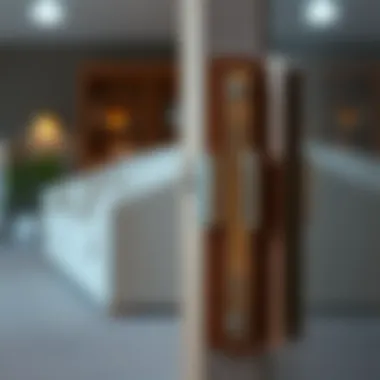
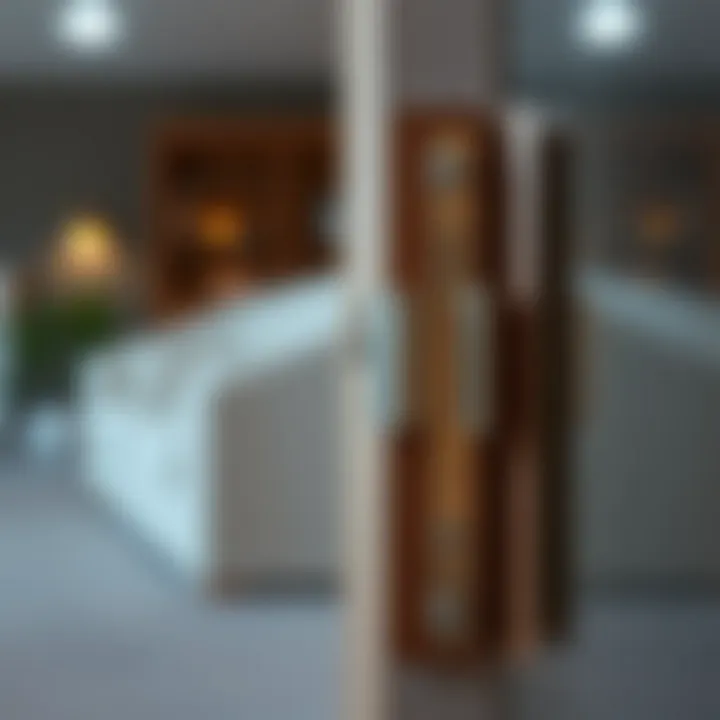
Aesthetic Considerations
Modern vs. Traditional Styles
The aesthetics of modern design often lean towards sleek, clean lines. Modern soft close hinges typically come in materials like brushed nickel or matte black, which complement contemporary cabinetry and provide a minimalist touch. The key characteristic of modern styles is their ability to blend seamlessly into the background, allowing the cabinetry itself to shine without distraction. On the other hand, traditional designs favor more ornate finishes like bronze or antique brass, showcasing craftsmanship with a touch of elegance akin to classic furnishings.
A distinct unique feature of modern soft close hinges is the square-edge design, which fits snugly and often remains hidden when the door is closed. This allows for a beneficial aspect; it helps create a sophisticated and modern look. In contrast, traditional styles can offer a disadvantage if the goal is to maintain a minimalist space, as ornate designs may stand out more than desired. Thus, choosing the right type depends on the overall theme of the interior.
Color Coordination
Color coordination emerges as a significant element when selecting soft close hinges. The primary aspect here is ensuring that the color of the hinges complements the surrounding decor, creating a cohesive look. For instance, matching a hinge's finish to cabinet handles or light fixtures can pull a room together, fostering a sense of unity and style. In this article, we discuss how color coordination can turn ordinary doors into standout features.
One notable characteristic of effective color coordination is the ability to invoke a feeling in a space. A subjective yet beneficial choice can be to choose hinges that blend in, creating an understated elegance, or to opt for contrasting colors that attract attention. For example, matte black hinges on a white cabinet can create a stunning focal point, while polished brass hinges on dark wood cabinetry can add warmth and richness. However, there is a trade-off; overly bright or mismatched colors might clash and degrade the desired ambiance.
Functional Aesthetics
Soft close hinges are functional without compromising their beauty. This balance allows designers and homeowners to focus on both practicality and visual impact. Functionality is not merely about convenience; it encompasses how these hinges can enhance the overall charm of a room.
By deftly combining beauty with performance, soft close hinges provide a dual advantage. They operate smoothly, reducing noise during entry or exit, thereby promoting a tranquil environment. This allows for an inviting atmosphere while also maintaining elegance. In essence, the ability to seamlessly integrate with varied design elements further solidifies their importance in the conversation around modern interior design.
In summary, soft close hinges shouldn’t just be seen as hardware; they should be celebrated as an integral piece of the design puzzle, linking functionality, aesthetic appeal, and user experience together.
Comparative Analysis with Traditional Hinges
When it comes to door hardware, the type of hinge can make a world of difference, especially when comparing soft close door hinges to traditional ones. Understanding this comparison is crucial for homeowners, interior decorators, and anyone looking to reinvent their living spaces. Soft close hinges not only offer smoother operation but also bring a host of advantages that can significantly enhance day-to-day usage of doors.
Now, let's dig into the nitty-gritty of these two styles, examining why this comparison matters and what benefits it can present.
Performance Metrics
Performance is the name of the game when choosing door hinges. Traditional door hinges have been around for ages, relying on a basic design that allows the door to swing open and shut. This simplicity can be appealing, but it often leads to drawbacks. Doors can slam shut quickly, causing noise and potential damage to the door frame or the wall. In comparison, soft close hinges integrate mechanisms that allow for a controlled, gentle closure.
To break it down further:
- Closing Speed: With traditional hinges, the closing speed is often unpredictable. Soft close hinges, however, slow down the door as it nears the hinge frame, ensuring a quiet operation.
- User Experience: Homeowners report a more pleasant experience when using soft close hinges, especially in high-traffic areas where slamming doors can become a nuisance.
- Durability: Soft close hinges tend to reduce wear and tear on the door and the frame due to their cushioned closing, potentially extending the lifespan of both.
Cost-Benefit Analysis
When weighing the cost of hinges against their benefits, it’s not as simple as looking at the price tag. Sure, traditional hinges may seem cheaper upfront, but it’s essential to consider the long-term expenses and inconveniences associated with them.
- Initial Investment: While soft close hinges can be pricier than traditional models, this initial investment pays off over time by reducing the need for repairs and replacements after slamming incidents.
- Maintenance Costs: Traditional hinges often require more maintenance due to friction and wear, which can lead to squeaking or misalignment. On the other hand, soft close hinges with their internal dampers often require little to no maintenance.
- Enhanced Safety: For families with young children, soft close hinges can prevent pinched fingers – a cost factor that no parent should overlook. The safety benefits alone could save on potential medical expenses from injuries caused by slamming doors.
Future Trends in Door Hardware
As the world continues to evolve, so does the hardware that keeps our homes functional and stylish. Understanding future trends in door hardware is essential for homeowners, interior decorators, designers, furniture retailers, and DIY enthusiasts. It's not merely about upgrading functionality; it's about enhancing the experience of using doors in our spaces. This section delves into the pillars of innovations that are reshaping how we perceive soft close door hinges and other hardware.
Innovations in Soft Close Technology
Soft close technology has come a long way since its inception. The latest developments focus on increasing durability while simplifying installation. New mechanisms are being engineered, allowing soft close hinges to respond more effectively, adjusting to changes in environmental conditions—think humidity and temperature fluctuations that affect wood. These hinges can often accommodate a wider array of door weights without compromising their effectiveness.
- Integration of Smart Technology: Some of the buzz is around smart systems that can automatically adjust closure speeds based on the user's previous patterns. Imagine a hinge that learns your habits over time! This could significantly reduce wear and tear.
- Increased Customization: With consumer preferences shifting towards personalized solutions, manufacturers are offering more customizable options for finishes and capabilities. Homeowners can now match their hardware more closely with their overall interior design.
"The future hinges are not just about smoother operations; it's about smarter choices that resonate with our lifestyles."
Sustainability and Eco-Friendly Options
As eco-conscious living takes the front seat, sustainability in hardware design is becoming a measure of quality and responsibility. Sustainable construction is more than just a trend; it’s a necessity. When it comes to door hardware, particularly soft close hinges, here are some noteworthy aspects:
- Materials Matter: There’s a significant move toward using recycled materials in the production of hardware, reducing waste and promoting resource efficiency. Metal alloy hinges recycled from manufacturing leftovers stand as a prime example.
- Long Life Cycles: Innovations that extend the lifespan of soft close hinges are gaining traction. By focusing on durability, we not only save costs but also reduce the frequency of replacements, contributing to less waste in landfills.
- Energy-Efficient Manufacturing: Brands are optimizing their production processes to be less energy-intensive. This means the environmental footprint of creating soft close hinges is shrinking, making a positive impact on our planet.
In reflection, as trends continue to shape the ubiquitous nature of door hardware — particularly soft close hinges — the focus has shifted toward smarter, more sustainable solutions. Homeowners and industry professionals alike can look forward to better-performing products that align with aesthetic preferences and ethical considerations.
Culmination
In this article, we’ve traversed the world of soft close door hinges, uncovering their significance not only in functionality but in enhancing the overall aesthetic of spaces where they are employed. Soft close hinges play a crucial role in the daily operation of doors, ensuring gentle closure that protects against slamming and wear and tear. This thoughtful design ultimately extends the lifespan of both doors and hinges themselves.
One of the standout features of soft close hinges is their ability to offer safety benefits. Homeowners, especially those with young children or pets, find these hinges essential as they reduce the risk of injury associated with abruptly closing doors. Moreover, they contribute to quieter living spaces, an essential element for harmony in any home environment.
Summary of Key Points
- Functionality: Soft close hinges operate using a hydraulic mechanism that controls the door movement, allowing for a smooth, controlled closure.
- Safety: These hinges significantly decrease the chance of injuries from unexpected door slams, providing peace of mind, particularly in homes with children.
- Durability: The design of soft close hinges often leads to less wear on both the hinge and the door itself, prolonging their effective lifespan.
- Aesthetic Appeal: Available in various finishes and styles, these hinges can complement different interior designs, enhancing the visual appeal of spaces.
Final Thoughts on Soft Close Door Hinges
Soft close door hinges stand at the intersection of convenience and style. Their growing popularity among homeowners, interior decorators, and designers speaks to their dual role in functionality and design. As we’ve explored various aspects—from installation processes to maintenance tips—it is clear that investing in quality soft close hinges is a decision that pays off over time.
When choosing the right soft close hinges, one should carefully weigh factors like door size, weight, and style to ensure optimal compatibility. The richer architectural experience offered by soft close technology elevates spaces and adds a modern touch. This combination of safety, durability, and aesthetic embodiment makes soft close door hinges a quintessential component in today’s homes.
For those pondering whether to integrate these hinges into their designs, the answer is a resounding yes. Embracing soft close technology not only speaks to sophistication in design but also addresses practical needs in everyday life. The sonorous quiet of a softly closing door is indeed a luxury worth having.



